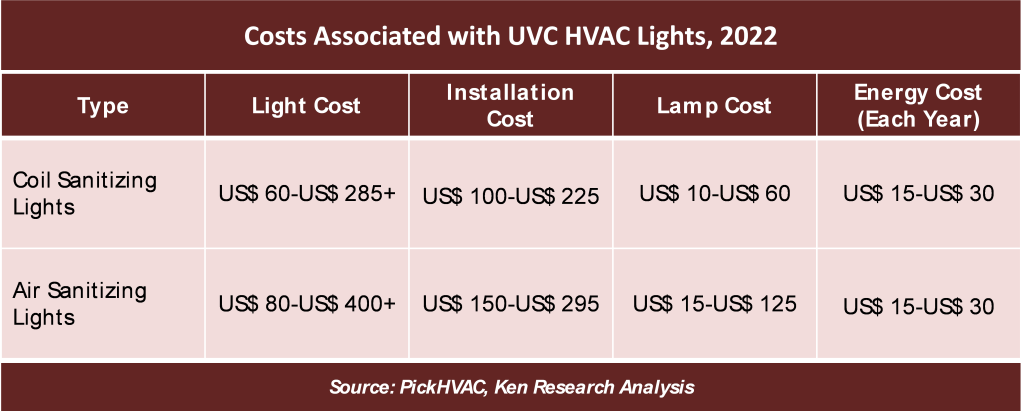Driven by the rising adoption of smart home devices across countries along with the increasing government policies and strategies regarding energy savings, the Global UV LED Market is forecasted to Cross US$1,100 Mn by 2028 says Ken Research Study.
UV LEDs (Ultraviolet Light-Emitting Diodes) are solid-state electrical devices that emit light in the ultraviolet (UV) spectrum. They are suitable for a wide range of applications, including curing, disinfection/purification, skin treatments (such as psoriasis and vitiligo), and more, as they are more energy-efficient, lose very little heat, contain no mercury, and have a much smaller carbon footprint than traditional UV lights. Furthermore, UV lights are classified into three categories: UV-A, UV-B, and UV-C. UV-C radiation is currently gaining popularity in medical and biology labs, particularly following the outbreak of the COVID-19 pandemic, to sterilize tools and workspace surface areas in order to minimize the risk and transmission of infections/diseases.
Ken Research shares 3 key insights on this high opportunity market from its latest research study.
1. The Ongoing COVID-19 Pandemic has emphasized the Need to Develop and Demonstrate Advanced Disinfection Technologies for Inactivating Pathogenic Microorganisms.
The outbreak of the COVID-19 pandemic has exacerbated involvement in resolving viral transmission issues. In response to such concerns, a number of research studies/investigations examining the use of UV-C radiation to inactivate viruses were primed. UV-C typically inactivates pathogens, such as bacteria and viruses by damaging photochemical reactions in DNA and RNA, resulting in microbe inhibition. In addition, it also utilizes specific wavelengths of the ultraviolet spectrum, typically ranging from 200 to 280 nanometers, whereas UV-B wavelengths range from 280 to 320 nanometers.
For instance, according to the study conducted by U.S. Food and Drug Administration (US FDA), a U.S. federal agency, on UV Lights and Lamps in 2021, UVC radiation has been confirmed to dismantle the outer protein coating of the SARS-Coronavirus, which, in turn, eventually results in virus inactivation.
According to the 2020 report on germicidal UV conducted by Illuminating Engineering Society (IES), a U.S.-based non-profit organization devoted to improving the lighted environment, UV-C is the most effective part of the spectrum, with kill rates of over 99.9%.
According to the International Ultraviolet Association, a U.S.-based non-profit organization, UV-C is the only UV that can kill microorganisms, such as viruses and bacteria by causing DNA, protein, and RNA damage. In addition, a dose of 40 mJ cm of 254 nm UV-C light kills 99.9% of "any microbial pathogens".
According to Ken Research estimates the Global UV LED Market was valued at US$ 350 Mn in 2017, it is estimated to be US$ 600 Mn in 2022 and is expected to grow further into a ~US$ 1,060 Mn opportunity by 2028.
2. Increasing Government Strategies to Lower CO2 emissions across Industries are propelling the UV LED Market Growth.
Several governments across countries are implementing climate action strategies in a variety of areas, including energy, to become largely greenhouse gas-neutral. For instance, according to Collaborative Labeling and Appliance Standards Program (CLASP), a U.S.-based non-profit organization that provides technical and policy support to governments, lighting accounts for nearly 5% of global CO2 emissions. A global shift to energy-efficient light-emitting diode (LED) technology could save more than 1,400 million tonnes of CO2 and prevent the construction of 1,250 power plants.
Request for Sample Report @ https://www.kenresearch.com/sample-report.php?Frmdetails=NTk2MDI5
Furthermore, traditional UV lights typically disperse energy in form of heat when an electric current passes through them, which minimizes their efficiency. Conversely, UV-C LEDs convert nearly 90% of electricity into UV-C rays, and their generation occurs immediately after switching on, reducing energy consumption even further. According to the Multidisciplinary Digital Publishing Institute (MDPI), a Switzerland-based publisher of peer-reviewed, and open-access journals, UV-C LED lamps emit 50% less CO2, and replacing mercury lamps with UV LED lamps can save 67 tonnes of CO2 per year. In addition, other greenhouse gases, such as ozone, would also be considerably reduced since UV-C LEDs do not produce ozone, unlike conventional mercury vapor lamps.
3. UV LEDs are Considerably More Expensive Technology than Other Alternatives due to their Highers Ink Costs, which are Made Primarily with a Special Photo initiator and Formulation, Diminishing their Market Growth.
UV LED ink is more expensive as its formulations differ significantly from traditional inks, and the limited range of photo initiators that operate at the larger wavelengths used in UV LEDs is much more expensive. For instance, in 2022, according to Yosun, a Japanese company that specializes in the sales and service of semi-conducting electronic components, a UV printer with an adjustable ink cartridge typically costs between US$ 20,000 and US$ 30,000. Furthermore, UV LEDs technology, particularly UV-C LED that can disinfect large areas without chemical compounds is extremely expensive as the initial cost of formulating equipment is higher than the cost incurred on conventional UV technologies. For instance, according to Regency Lighting, a U.S.-based lighting distributor with a specialty in lighting maintenance, design, construction, replacement products, and recycling, the average cost of a UV-C fixture ranges between US$ 150 to US$ 20,000.
The table below outlines four costs associated with UVC Heating, ventilation, and air conditioning (HVAC) lights, which are electric lights that produce ultraviolet C (UVC) light and are used for air purification and sterilization in the Heating, ventilation, and air conditioning (HVAC) system.
For more information on the research report, refer to the below link:
Global UV LED Market Size, Segments, Outlook, and Revenue Forecast 2022-2028: Ken Research
Follow Us
LinkedIn | Instagram | Facebook | Twitter
Contact Us: –
Ken Research
Ankur Gupta, Head Marketing & Communications
+91-9015378249



